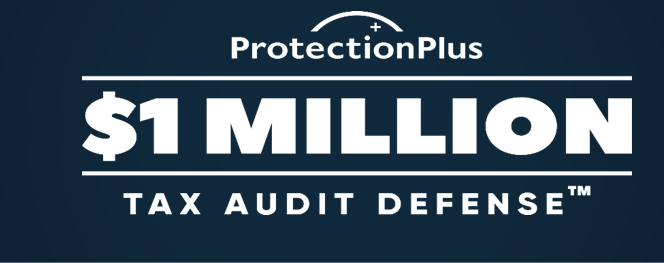
Tax Audit Defense™




PROTECTION PLUS COVERAGE
For a reasonable annual subscription fee, you will receive the following benefits and services:

Get ready for taxes: Here’s what’s new and what to consider when filing in 2022
The IRS encourages taxpayers to get informed about topics related to filing their federal tax returns in 2022. These topics include special steps related to charitable contributions, economic impact payments and advance child tax credit payments. Taxpayers can visit IRS.gov/getready for online tools, publications and other helpful resources for the filing season.
Here are some key items for taxpayers to know before they file next year.
Changes to the charitable contribution deduction
Taxpayers who don’t itemize deductions may qualify to take a deduction of up to $600 for married taxpayers filing joint returns and up to $300 for all other filers for cash contributions made in 2021 to qualifying organizations.
Check on advance child tax credit payments
Families who received advance payments will need to compare the advance child tax credit payments that they received in 2021 with the amount of the child tax credit that they can properly claim on their 2021 tax return.
In January 2022, the IRS will send Letter 6419 with the total amount of advance child tax credit payments taxpayers received in 2021. People should keep this and any other IRS letters about advance child tax credit payments with their tax records. Individuals can also create or log in to IRS.gov online account to securely access their child tax credit payment amounts.
Economic impact payments and claiming the recovery rebate credit
Individuals who didn’t qualify for the third economic impact payment or did not receive the full amount may be eligible for the recovery rebate credit based on their 2021 tax information. They’ll need to file a 2021 tax return, even if they don’t usually file, to claim the credit.
Individuals will need the amount of their third economic impact payment and any plus-up payments received to calculate their correct 2021 recovery rebate credit amount when they file their tax return.
In early 2022, the IRS will send Letter 6475 that contains the total amount of the third economic impact payment and any plus-up payments received. People should keep this and any other IRS letters about their stimulus payments with other tax records. Individuals can also create or log in to IRS.gov online account to securely access their economic impact payment amounts.
More information:
Reconciling Your Advance Child Tax Credit Payments on Your 2021 Tax Return

IRS issues information letters to Advance Child Tax Credit recipients and recipients of the third round of Economic Impact Payments; taxpayers should hold onto letters to help the 2022 Filing Season experience
The Internal Revenue Service announced on 12-22-2021 that it will issue information letters to Advance Child Tax Credit recipients starting in December and to recipients of the third round of the Economic Impact Payments at the end of January. Using this information when preparing a tax return can reduce errors and delays in processing.
The IRS urged people receiving these letters to make sure they hold onto them to assist them in preparing their 2021 federal tax returns in 2022.
Watch for advance Child Tax Credit letter
To help taxpayers reconcile and receive all of the Child Tax Credits to which they are entitled, the IRS will send Letter 6419, 2021 advance CTC, starting late December, 2021 and continuing into January. The letter will include the total amount of advance Child Tax Credit payments taxpayers received in 2021 and the number of qualifying children used to calculate the advance payments. People should keep this and any other IRS letters about advance Child Tax Credit payments with their tax records.
Families who received advance payments will need to file a 2021 tax return and compare the advance Child Tax Credit payments they received in 2021 with the amount of the Child Tax Credit they can properly claim on their 2021 tax return.
The letter contains important information that can make preparing their tax returns easier. People who received the advance CTC payments can also check the amount of their payments by using the CTC Update Portal available on IRS.gov.
Eligible families who did not receive any advance Child Tax Credit payments can claim the full amount of the Child Tax Credit on their 2021 federal tax return, filed in 2022. This includes families who don’t normally need to file a tax return.
Economic Impact Payment letter can help with the Recovery Rebate Credit
The IRS will begin issuing Letter 6475, Your Third Economic Impact Payment, to EIP recipients in late January. This letter will help Economic Impact Payment recipients determine if they are entitled to and should claim the Recovery Rebate Credit on their tax year 2021 tax returns that they file in 2022.
Letter 6475 only applies to the third round of Economic Impact Payments that was issued starting in March 2021 and continued through December 2021. The third round of Economic Impact Payments, including the “plus-up” payments, were advance payments of the 2021 Recovery Rebate Credit that would be claimed on a 2021 tax return. Plus-up payments were additional payments the IRS sent to people who received a third Economic Impact Payment based on a 2019 tax return or information received from SSA, RRB or VA; or to people who may be eligible for a larger amount based on their 2020 tax return.
Most eligible people already received the payments. However, people who are missing stimulus payments should review the information to determine their eligibility and whether they need to claim a Recovery Rebate Credit for tax year 2020 or 2021.
Like the advance CTC letter, the Economic Impact Payment letters include important information that can help people quickly and accurately file their tax return.
More information about the Advance Child Tax Credit, Economic Impact Payments and other COVID-19-related tax relief may be found at IRS.gov.
As the 2022 tax filing season approaches, the IRS urges people to make sure an accurate tax return and use electronic filing with direct deposit to avoid delays.

WASHINGTON — The Internal Revenue Service today reminded retirement plan participants and individual retirement account owners that payments, called required minimum distributions, must usually be taken by Dec. 31.
Required minimum distributions (RMDs) generally are minimum amounts that retirement plan account owners must withdraw annually starting with the year they reach 72 or, if later, the year they retire. However, if the retirement plan account is an IRA or the account owner is a 5% owner of the business sponsoring the retirement plan, the RMDs must begin once the account holder is age 72, even if they’re still working. RMD amounts not timely withdrawn from accounts may be subject to penalties.
Individuals who reached 70 ½ in 2019, (70th birthday was June 30, 2019 or earlier) did not have an RMD due for 2020, but will have to take one by Dec. 31, 2021.
Individuals who reach 72 in 2021 (and their 70th birthday was July 1, 2019 or later) have their first RMD due by April 1, 2022.
The required distribution rules apply to:
Roth IRAs do not require distributions while the original owner is alive.
An IRA trustee, or plan administrator, must report the amount of the RMD to the IRA owner. An IRA owner, or trustee, must calculate the RMD separately for each IRA owned. However, they can choose to withdraw the total amount from one or more of the IRAs. In contrast, RMDs required from workplace retirement plans must be taken separately from each plan. Not taking a required distribution, or not withdrawing enough, could mean a 50% excise tax on the amount not distributed.
The RMD is based on the taxpayer’s life expectancy and their account balance. Often, a trustee will use Form 5498, IRA Contribution Information, to report the RMD to the recipient. For most taxpayers, life expectancy used to calculate the RMD is based on Uniform Lifetime Table III in Publication 590-B, Distributions from IRAs. Individuals can use online worksheets on IRS.gov to figure the RMD.
2020 RMDs
An IRA owner or beneficiary who received an RMD in 2020 had the option of returning it to their account or other qualified plan to avoid paying taxes on that distribution. A 2020 RMD that qualified as a coronavirus-related distribution may be repaid over a 3-year period or have the taxes due on the distribution spread over three years. A 2020 withdrawal from an inherited IRA could not be repaid to the inherited IRA but may be spread over three years for income inclusion.
IRS online tools and publications can help
Taxpayers can find frequently asked questions, forms and instructions and easy-to-use tools at IRS.gov.